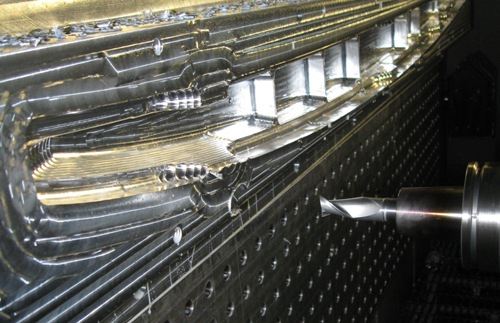Basic Questions on High Speed Machining
Can HSM apply to turning? Does the “speed” refer to cutting speed or spindle speed? What is the explanation behind lower forces and lower heat generation?
A reader recently used the “Ask an Expert” feature of our High Speed Machining Zone to ask a series of questions aimed at better understanding high speed machining.
Questions
1. Is HSM applicable in turning?
2. For HSM, which is more important, cutting speed or spindle rpm? Specifically, if I use a very large-diameter cutter, I will have high cutting speed but low spindle rpm. Can this be regarded as HSM?
3. What are the "physics" behind low cutting forces and low residual stresses in HSM?
4. Is the heat generated in HSM more than in conventional machining?
Response from Tom Delio, co-founder of BlueSwarf
1. HSM can apply in turning. However, since turning is generally a slower operation and has much different dynamic behavior, the opportunity that HSM gives for optimization of the process is much more limited. Although HSM is not strictly tied to spindle speed, it is a frequency-based/spindle speed opportunity. So the more spindle speed you have available, the more opportunity to reap the benefits of HSM.
2. HSM is really tied to the frequency signature of the machine and tooling. You can think of it this way: We are trying to find speeds (commanded rotating frequencies) that work well with the signature frequencies of the machine and tool. The signature frequencies can vary widely depending on the exact configuration, size of machine and size of tooling utilized. When the commanded frequency (rpm) is much, much different from the signature frequencies, then there is generally not a big problem. However when the frequencies are of relatively the same order, say within a factor of 10, then HSM has effects. So in the case of a short, small-diameter cutter which has very high frequencies, you will need to run at very high speeds (frequencies) to see the benefits of HSM. For very large, long and flexible cutters you will generally see low frequencies, and therefore running even at relatively low spindle speeds will show benefits of HSM. As a result, you could reasonably conclude there is a very weak correlation with surface speed since large heavy cutters will generally have large diameters and small high frequency cutters will have smaller diameters. This is not to say there is any reliable "rule of thumb." The behavior of any given configuration of machine, tool, holder and spindle is so counter-intuitive that it either requires very extensive computer modeling or a direct measurement of the frequency signature to know exactly how things will behave and what speed range is considered HSM.
3. Machining is generally either about high metal removal rate or high surface area generation rate. Both can be roughly tied to horsepower. Horsepower is a function of speed and cut thickness or cutting force. Cutting force, of course, correlates well to residual stress. If I can run at very high spindle speeds, then I don't need as much cutting force (depth of cut, width of cut, chip thickness) to achieve the same power and therefore metal removal rate or surface generation rate. Therefore I will generally produce lower residual stress. Of course, this all has to be considered with respect to the heat generated at higher speed. But generally, particularly in the case of aluminum, high speeds are very beneficial to residual stresses since for similar or even higher productivity the cutting forces are lower.
4. In general, the heat will be higher in HSM, but there is a consideration in cases of hard metals and finishing. Because we can run at much less engagement and get similar MRR at higher speeds, this allows for interrupted cutting to permit cooling of the cutter between impacts and also not as much heat spike during cutting, since the engagement lasts much less. One can very effectively balance the thermal cycling so as to not damage the cutting edge and also get the benefits of HSM.
Related Content
YCM Alliance Hits IMTS
YCM Technology has joined with other like-minded machine tool manufacturers to take a solutions-based approach to manufacturing.
Read MoreHow to Accelerate Robotic Deburring & Automated Material Removal
Pairing automation with air-driven motors that push cutting tool speeds up to 65,000 RPM with no duty cycle can dramatically improve throughput and improve finishing.
Read MoreRead Next
The Cut Scene: The Finer Details of Large-Format Machining
Small details and features can have an outsized impact on large parts, such as Barbco’s collapsible utility drill head.
Read More3 Mistakes That Cause CNC Programs to Fail
Despite enhancements to manufacturing technology, there are still issues today that can cause programs to fail. These failures can cause lost time, scrapped parts, damaged machines and even injured operators.
Read More















.png;maxWidth=300;quality=90)

.png;maxWidth=300;quality=90)







